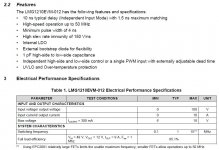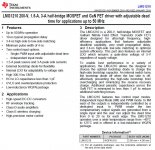Does GaN still have more noise than silicon?
The GaN FET is only used as a switch and has very low Rds-on, so noise in the linear sense is not an issue. There are more issues with dead time, switching jitter & parasitic inductance causing excess overshoot from poor layout.
Use of GaN power FETs for switching applications requires very careful layout & proper design techniques. It is not as forgiving as slower Si FET switches.
+1
I also would like to add that the use of GaN in class D is not because of better audio quality, but because of better efficiency.
That in turn would allow higher power with lower losses, thus smaller, cooler running amps.
Jan
I also would like to add that the use of GaN in class D is not because of better audio quality, but because of better efficiency.
That in turn would allow higher power with lower losses, thus smaller, cooler running amps.
Jan
In costrast with Si Fets, there is almost zero Reverse recovery charge Qrr in GAN fet and also much lower Coss. So, if both carefully implemented well, GAN should have better audio quality in terms of Distortion performance theoretically.
In costrast with Si Fets, there is almost zero Reverse recovery charge Qrr in GAN fet and also much lower Coss. So, if both carefully implemented well, GAN should have better audio quality in terms of Distortion performance theoretically.
Theoretically, indeed. If the difference in distortion is such that creative use of feedback and feedforward can eliminate it almost completely in both cases, the difference between the residual distortion can be beyond measurement limits. Or not, of course. The beautiful Orchard audio amplifier modules are smaller than the Purifi ones, and probably more efficient, but the measurements are not better. Still in all cases beyond audibility, as reviewers have found.
I would really like to have GaN-based power supplies for my Purifi modules instead. This should bring overall efficiency up another (little) notch.
Does GaN still have more noise than silicon?
I have not tried yet GaN.
SO just a bit worry, that driving GaN is totally different with driving Mosfet. If you study, driving GaN is like a tricky way even with specific driver or the GaN itself constructed using tricky technique.
I am still feel as old guy way. I still think ideally that driving ON means giving signal ON. 😀
Currently I am working with Pro Audio which at 300kHz or less, conventional mosfet is still a good choice.
Infineon have simple discrete adapter circuit to drive GaN with standard Mosfet Gate driver
in this case UcD FD1K or D2KFB-DBF-UCD Combo should work
I can post simple adapter circuit in the group
Infineon add simple discrete adapter circuit to IRS20957 and drive Gan
in this case UcD FD1K or D2KFB-DBF-UCD Combo should work
I can post simple adapter circuit in the group
Infineon add simple discrete adapter circuit to IRS20957 and drive Gan
Irs20957 bad driver for gan , need use drivers with a little delay. Si8231 as in purufi, lmg1210, etc.
Infineon have simple discrete adapter circuit to drive GaN with standard Mosfet Gate driver
in this case UcD FD1K or D2KFB-DBF-UCD Combo should work
I can post simple adapter circuit in the group
Infineon add simple discrete adapter circuit to IRS20957 and drive Gan
Thanks NMOS,
Easiest way is cascoding GaN with conventional Mosfet 😀
If using specific driver then new completely circuit have to be made. Soon or later GaN will knock your door and you must prepare.
The TI evaluation board allows one to experiment with a little more layout safety margin on the GaN drive.
Thanks Mello4.
It seems so simple application.
Why not use the now expired bash patent... and avoid all the unnecessary and highly distorting parts/aspects of standard class D design? I don't get it....
Little bump here.
By now these patents are fully expired, so open for anyone to be used.
I am actually kinda surprised that not a lot of people/companies jumped in?
By now these patents are fully expired, so open for anyone to be used.
I am actually kinda surprised that not a lot of people/companies jumped in?
Little bump here.
By now these patents are fully expired, so open for anyone to be used.
I am actually kinda surprised that not a lot of people/companies jumped in?
Many have already delved into the uniqueness of these patents on commercial scale (hush, hush). After spending years exploring the details and asking pertinent questions, some features of these patents are notably reproducible.
Key Features of the Patents:
- Microcontrol control monitoring. (innovation lies in the firmware)
- Anti-windup Integrator clipping. (PID theory)
- OC trips utilizing the first point (MCU monitoring).
- Differential second-order integrator (basic analog skills).
- Undisputed THD (Total Harmonic Distortion) figures, which rely on Esoteric Math Modeling. This remains a challenging area for DIY enthusiasts
Bruno Putzey is the master in this? 5th order compensator. maybe reading the work from Christophe Basso may help using Transfer function. FACTs method?
- Dynamic Control theory.
- Control theory during failure modes.
- Control theory during clipping.
- Control theory during amplifier recovery.
- Elaboration on feedback paths, explained using Resistors and Capacitors.
for corporate settlement. the small companies indefinitely copied most of this stuff without blowback.
Once gain, I am not talking about nCore or similar, I am talking about UCD.Many have already delved into the uniqueness of these patents on commercial scale (hush, hush). After spending years exploring the details and asking pertinent questions, some features of these patents are notably reproducible.
Key Features of the Patents:
Advanced Technical Details:
- Microcontrol control monitoring. (innovation lies in the firmware)
- Anti-windup Integrator clipping. (PID theory)
- OC trips utilizing the first point (MCU monitoring).
- Differential second-order integrator (basic analog skills).
Deep Dive into Control Theory:
- Undisputed THD (Total Harmonic Distortion) figures, which rely on Esoteric Math Modeling. This remains a challenging area for DIY enthusiasts
Bruno Putzey is the master in this? 5th order compensator. maybe reading the work from Christophe Basso may help using Transfer function. FACTs method?
It's worth noting that using a second-order integrator should suffice for most applications these patents make nice argumentative cases
- Basic Control theory.
- Control theory during failure modes.
- Control theory when clipping occurs.
- Control theory during amplifier recovery.
- Elaboration on feedback paths, explained using Resistors and Capacitors.
for corporate settlement. the small companies indefinitely copied most of this stuff without blowback.
UCD on itself is pretty straightforward.
- Home
- Amplifiers
- Class D
- UcD patent expired?

